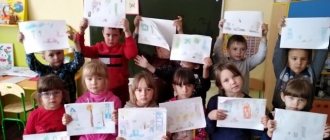Lesson plan on traffic rules for the preparatory group
Outline of complex thematic lessons “The Road and We” for the preparatory group
Author: Nadezhda Viktorovna Vinogradova, teacher at GBDOU d/s No. 14, St. Petersburg.
Description: the material will be of interest to older preschoolers and educators Goal: to consolidate knowledge of traffic rules Objectives: to develop in children the habit of behaving correctly on the roads, to educate them as competent pedestrians, to develop cognitive activity as a road user;
promote the development of caution, caution on the roads, cultivate attention, concentration, and the ability to apply acquired knowledge in everyday life. I. Formation of a holistic picture of the world
Topic: “We are pedestrians” Goals and objectives: to clarify knowledge of some road signs; clarify the knowledge that all movement in the city is subject to special rules; consolidate knowledge of the rules for crossing the roadway; instill responsibility for one’s safety, generalize the understanding of the work of traffic police officers. Demonstration equipment: image of road signs. Progress of the lesson: The teacher reads a poem: I walk towards the traffic light In full view of passers-by.
Only at the zebra crossing, I know for sure, I will cross the road. — What would happen if people and cars stopped following traffic lights? — What would happen if the road signs suddenly disappeared: “Pedestrian crossing”, “Caution, children!”, “Bus stop location”? Places road signs on the board, reads riddles, asks to find the answer on the board: A round sign with a window in it, Don’t rush rashly, but think a little: What’s here, a brick dump? (“the passage is closed”) I’m in a circle with a red outline, This means it’s dangerous here. Here, understand, there is a ban... (pedestrian traffic) I’m walking in a blue circle, And it’s clear to the whole neighborhood, If you think about it a little -... (pedestrian path) You and I were walking from the garden, We see a sign on the pavement: Circle, bicycle inside, Nothing else No. (bicycle path) I want to ask about the sign. It’s drawn like this: In a triangle, the guys are running as fast as they can somewhere. (“Caution, children!”) Task: find signs according to the description: - prescriptive: “Bus stop”, “tram stop”, “medical point”, “food point”, “pedestrian crossing”, “underground pedestrian crossing”, “ bicycle path", "pedestrian path" - prohibiting: "be careful, children!", "entry is prohibited", "cycling is prohibited", "crossing is prohibited" - warning: "be careful, children!", "railway crossing", " road works” The teacher gives each sign to the child who guessed it. Then he clarifies that there are signs for motorists (“stopping is prohibited”, “parking is prohibited”, “entry is prohibited”, “caution, children!”, “move straight ahead”, main road) for pedestrians (“underground passage”, “overground crossing" "crossing prohibited",) and signs for pedestrians and motorists ("pedestrian crossing", "bus stop") and invites children to take turns raising signs for pedestrians, for drivers and for pedestrians and drivers (see photo No. 1 game " road signs"). The teacher asks questions: - Remember what rules pedestrians must follow? — Which services in the city are responsible for traffic safety? The teacher deciphers the abbreviation of the traffic police, clarifies the role of the traffic police officer and offers to visit the children's playground with an imitation of a road, a pedestrian crossing, with signs and a sculpture of a traffic police officer in the center of the playground on the weekend. II.
Introduction to verbal creativity. Topic: D. Orlov's story “New Adventures of Stobed” from the magazine “Health” (reading) Purpose: reading the story Objectives: consolidate knowledge of the rules of safe behavior on the street; contribute to the correct perception of the story; continue to instill responsibility for your safety. Demonstration equipment: illustration for this story. Progress of the lesson: The teacher offers to listen to D. Orlova’s story “The New Adventures of Stobed” from the magazine “Health” about the wooden naughty boy Stobed, who slid down a hill and ended up on the roadway.
Questions: - What is the story about? — What mistakes did the boy make? — What conclusions can you draw for yourself? III.
Speech development. Topic: “The road does not tolerate pranks” Purpose: compiling a story based on the picture. Objectives: consolidate knowledge of the rules of safe behavior on the street; consolidate the ability to compose a story based on a plot picture; practice selecting synonyms, continue to instill responsibility for your safety. Demonstration equipment: A4 size pictures: children playing football near the roadway, a boy going down a slide onto the roadway, boys playing hockey on the road, a boy going down a slide onto the roadway. Progress of the lesson: Educator: - The road is a high-danger zone. You need to be careful when crossing it and staying near it. What do you think should not be done next to the road? (play, play around, jump out onto the road for a ball, balloon, etc.) Why? (this may cause an accident). The teacher invites the children to sequentially look at a series of paintings where the plot is children’s games near the roadway. Questions about the first picture: - what time of year is shown in the picture? —Where do the boys play? - What names can you give them to make a story about them? — What activities did the children choose near the road? According to the second picture: - Why was the boy on the roadway? - What could happen in such a situation? According to the third picture: - Why did the car crash into the house? — What were the boys doing on the road? From the fourth picture: - Why was the boy scared? — Where would it be safer to sled? - What can happen? Depending on the level of the children’s speech skills, the teacher offers four children to compose a narrative story in sequence, one picture for each child. Story plan: 1. What happened on the road?
2. How did the participants of the incident feel? 3. What rules did they break? When assessing the stories, the teacher notes the accuracy and consistency of the description, the use of definitions, the complexity of sentences, and the expressiveness of speech. IV.
Drawing Topic: “The road does not tolerate pranks” Purpose: drawing on the topic of compliance with traffic rules. Objectives: consolidate knowledge of the rules of behavior on the street; learn to depict various types of transport, their shape, proportions; consolidate drawing skills with simple and colored pencils, using an eraser; consolidate the ability to draw a human figure in motion; consolidate the ability to position an image using the entire area of the sheet. Demonstration equipment: A4 size pictures: children playing football near the roadway, a boy going down a hill onto the roadway, boys playing hockey on the road, a boy going down a hill onto the roadway; handout: album sheets, pencils, erasers, colored pencils, crayons, felt-tip pens. Progress of the lesson Teacher, demonstrating visual material: - Of course, you remember these pictures.
You made up stories based on them. Think about what these pictures have in common? (children play next to the road and this leads to an accident). The teacher invites the children to organize an exhibition of drawings in the group “The road does not tolerate pranks.” To do this, first of all, you need to think through the composition and content of the drawing in advance. Convey a simple story about the behavior of road users. Build a multi-faceted drawing, use the entire space of the foreground and background. Draw a sketch with simple pencils and carefully color in with colored pencils. Follow the rules for working with pencils. The teacher reminds children to observe the proportions between parts of objects, the proportions of parts of a person, as well as to convey the relationship of objects among themselves in size. Reminds you that in a drawing some objects may partially obscure other objects; you need to pay attention to this when drawing and painting. At the end of the lesson, the work is hung out for viewing. Children talk about their drawings: what exactly they wanted to show in their work, whether they managed to convey the situation on the road in a small plot drawing and correctly evaluate the actions of pedestrians and drivers. The teacher, together with the children, evaluates the drawings, notes what is interesting in design, the complexity of the location of the image on a sheet of paper (use of foreground and background), original solutions in composition, neatness, and observance of proportions relative to each other. V. Manual labor
Topic: “Making figurines of people for theatrical and play activities according to traffic rules” Purpose: making figurines of people. Objectives: to consolidate the ability to draw a person; strengthen the ability to work with pencils and scissors; consolidate knowledge of traffic rules, traffic lights; consolidate the ability to play a story game, negotiate the development of the plot with comrades; develop fantasy and imagination. Demonstration equipment: image of a human figure, two children's collective applications “On Our Street” in A1 format; handout: small rectangles of light yellow paper, pencils, erasers, colored pencils, felt-tip pens, scissors. Progress of the lesson Teacher, demonstrating a collective appliqué depicting a road, houses, cars, trees, traffic lights: - Remember, we recently made these two large appliqués? Everyone made their own house and one of the cars, you can easily recognize them. But look carefully, who is missing from the applications? (pedestrians). The teacher pays attention to which directions the green and red traffic lights are shining, where pedestrians could cross the road. Invites children, remembering the proportions of a person, to draw little men on small rectangles (in proportion to the houses and cars on the applique), color them and cut them out along the contour. Reminds you of the rules for using pencils and scissors, monitors the progress of children’s independent work, and helps as necessary. Children place cut-out figures on appliqués and play out the plot “I’ll go visit my neighbor.”
VI.
Independent activity of children Topic: Role-playing game “Traffic signals” Equipment: wooden model of a traffic light, toy cars.
We recommend watching:
Scenario of a game program on traffic rules for children of the preparatory group Booklet for parents of 1st grade on traffic rules Test with answers “Road rules” for grades 6-8 Poems for children on the topic: Traffic rules
Similar articles:
Traffic rules quiz for schoolchildren
Lesson summary on traffic rules on the topic “My friend the bicycle”, 4th grade
Drama on traffic rules for preschoolers. Preparatory group
Concert on traffic rules in the preparatory group
Thematic planning on traffic rules in the preparatory group of preschool educational institutions



